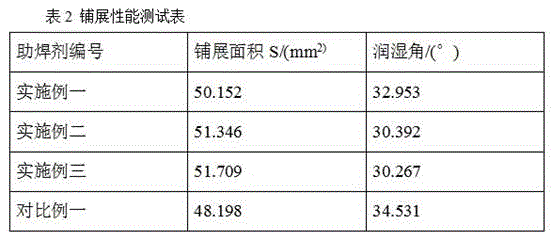Novel environmental-protection flux
A flux and environmental protection technology, applied in welding media, welding equipment, welding/cutting media/materials, etc., can solve problems such as need to be further excavated, cleaning agent hazards, cleaning technology and process steps, etc. Anti-corrosion properties, increased surface insulation resistance, improved solder wettability
- Summary
- Abstract
- Description
- Claims
- Application Information
AI Technical Summary
Problems solved by technology
Method used
Image
Examples
Embodiment 1
[0042] The distribution of each group is as follows:
[0043] 96 parts deionized water
[0044] 1.8 parts tripropylene glycol butyl ether
[0045] 1.0 parts glutaric acid
[0046] 0.85 part suberic acid
[0047] 0.1 parts succinic acid
[0048] 0.1 part hydroxybenzotriazole
[0049] 0.15 parts 50% glutaraldehyde
[0050] Preparation method: first place deionized water, glutaric acid, suberic acid, and tripropylene glycol butyl ether in an anti-corrosion container and mix and stir for 15 minutes. After the mixed solution is formed, add succinic acid, Hydroxybenzotriazole, 50% glutaraldehyde and other surfactants and additives were stirred for 60 minutes, and after stirring, cooling, and filtering processes, flux was finally prepared.
Embodiment 2
[0052] The distribution of each group is as follows:
[0053] 89 parts deionized water
[0054] 2.6 parts tetraethylene glycol dimethyl ether
[0055] 8.2 parts tripropylene glycol butyl ether
[0056] 0.3 parts polypropylene glycol 1200
[0057] 3.92 parts glutaric acid
[0058] 2.1 parts suberic acid
[0059] 1.03 parts sebacic acid
[0060] 0.3 parts succinic acid
[0061] 0.2 parts of hydroxybenzotriazole
[0062] 0.25 parts 50% glutaraldehyde
[0063] Preparation method: first place deionized water, glutaric acid, suberic acid, sebacic acid, tetraethylene glycol dimethyl ether, and tripropylene glycol butyl ether in an anti-corrosion container and mix and stir for 15 minutes. After the mixed solution is formed, add succinic acid, polypropylene glycol 1200, hydroxybenzotriazole, 50% glutaraldehyde and other surfactants and additives in turn and stir for 60 minutes. After stirring, cooling and filtering processes, it is finally prepared into flux .
Embodiment 3
[0065] The distribution of each group is as follows:
[0066] 90 parts deionized water
[0067] 2.6 parts tetraethylene glycol dimethyl ether
[0068] 8.2 parts tripropylene glycol butyl ether
[0069] 0.2 parts polypropylene glycol 1200
[0070] 1.95 parts glutaric acid
[0071] 1.05 parts suberic acid
[0072] 0.51 part sebacic acid
[0073] 0.26 part of secondary alcohol polyoxyethylene ether
[0074] 0.2 parts succinic acid
[0075] 0.19 part hydroxybenzotriazole
[0076] 0.19 parts 50% glutaraldehyde
[0077] Preparation method: first place deionized water, glutaric acid, suberic acid, sebacic acid, tetraethylene glycol dimethyl ether, and tripropylene glycol butyl ether in an anti-corrosion container and mix and stir for 15 minutes. After the mixed solution is formed, add succinic acid, polypropylene glycol 1200, hydroxybenzotriazole, secondary alcohol polyoxyethylene ether, 50% glutaraldehyde and other surfactants and additives in turn and stir for 60 minutes, ...
PUM
 Login to View More
Login to View More Abstract
Description
Claims
Application Information
 Login to View More
Login to View More - R&D
- Intellectual Property
- Life Sciences
- Materials
- Tech Scout
- Unparalleled Data Quality
- Higher Quality Content
- 60% Fewer Hallucinations
Browse by: Latest US Patents, China's latest patents, Technical Efficacy Thesaurus, Application Domain, Technology Topic, Popular Technical Reports.
© 2025 PatSnap. All rights reserved.Legal|Privacy policy|Modern Slavery Act Transparency Statement|Sitemap|About US| Contact US: help@patsnap.com



